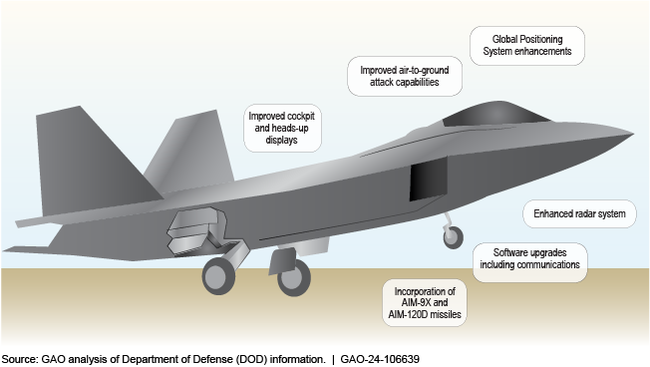F-22 Aircraft: Air Force Needs to Better Document Options Before Making Critical Decisions
Fast Facts
The Air Force proposed to divest—i.e., retire—its F-22 Block 20 aircraft without fully documenting the implications. Block 20s are used for training and aren't upgraded with the same capabilities as the rest of the fleet.
In its proposal to Congress, the Air Force didn't note key details such as how to train without Block 20s or whether they should be upgraded instead of retired. Congress didn't have enough data to make a decision—as was the case with a similar Air Force proposal we reported on in 2016.
We recommended that the Air Force collect data to inform its proposals, and that Congress consider requiring specific data in the proposals.
Capability upgrades that the Block 20 F-22s don’t currently have:

Highlights
What GAO Found
The Air Force decided to divest a portion of its aging F-22 aircraft used primarily for training—referred to as Block 20. The Air Force proposed Block 20 divestment to Congress without documenting key factors, such as training, mission capability, and testing, to inform that decision.
- The Air Force did not document how it will conduct F-22 training or testing—the current Block 20 functions—without Block 20 aircraft. It also did not document the challenges that combat units may face if mission-ready Block 30/35 aircraft are used for training or testing instead of Block 20s.
- The Air Force stated that divestment would result in cost savings from not flying Block 20s. These savings, however, did not account for other costs, such as maintenance for increased operations to make up for less aircraft.
The Air Force also obtained limited information about potentially upgrading as opposed to divesting Block 20 aircraft. The Air Force collected notional estimates from the F-22 prime contractor for upgrading Block 20s to the fleet's more modernized Block 30/35 level. The contractor estimated upgrades would cost at least $3.3 billion and take approximately 15 years to complete but did not provide supporting data. The Air Force determined this information was sufficient for its purposes. Without better evidence about the potential effects of either divesting or upgrading F-22 Block 20 aircraft, Congress may be impeded from making a well-informed decision on the merits of the Air Force's proposal.
F-22 Aircraft

Finally, the Air Force does not have guidance to document and provide Congress with information on its aircraft divestment determinations. A previous Air Force effort to divest aircraft provided insufficient details to Congress about the factors shaping that decision. GAO recommended in 2016 that the Department of Defense create divestment guidance to help ensure senior leadership, including Congress, has quality information. The Air Force did not agree and stated that it already had budget guidance. However, GAO's review of the Air Force's budget guidance found that it did not address providing Congress with sufficient data to make informed divestment decisions.
Why GAO Did This Study
The Air Force faces challenging decisions in modernizing its current aircraft while developing advanced capabilities to meet future threats. One such decision is whether to upgrade or divest 32 F-22 aircraft known as Block 20. The Air Force has not upgraded these to the same level as its 150 Block 30/35 aircraft—the modernized portion of the F-22 fleet. The Air Force's fiscal year 2023 budget proposal included Block 20 divestment, with the intent to use the savings to develop new types of aircraft.
Federal law includes a provision to prohibit the Air Force from divesting the aircraft until fiscal year 2028. It also includes a provision for GAO to assess issues related to upgrading the aircraft. This report addresses the extent to which the Air Force (1) had sufficient information to propose repealing the prohibition of divesting Block 20 aircraft, (2) had sufficient information to support upgrading Block 20 aircraft, and (3) has guidance to inform its divestment decisions.
To conduct this work, GAO reviewed an Air Force legislative proposal, cost and schedule estimates, and other relevant documentation. GAO also interviewed Air Force officials and a representative for the F-22 contractor.
Recommendations
Congress should consider requiring the Air Force to provide it with data and analyses before making certain aircraft divestment determinations. GAO is making two recommendations for the Air Force to fully document the options for divesting and upgrading Block 20 aircraft. The Air Force did not concur with GAO's recommendations. GAO believes its recommendations are valid, as discussed in the report.
Matter for Congressional Consideration
| Matter | Status | Comments |
|---|---|---|
| Congress should consider requiring the Air Force to provide specific types of data and analyses to Congress before making determinations to divest tactical aircraft. These data and analyses should include: cost assessments inclusive of all relevant factors, gaps in capacity and capability created by the divested asset, and realistic strategies for mitigating those gaps as well as the cost of these strategies. (Matter for Consideration 1) | We reviewed recent legislation and did not identify any congressional actions as of February 2025. |
Recommendations for Executive Action
| Agency Affected | Recommendation | Status |
|---|---|---|
| Department of the Air Force | Before making additional proposals to remove the prohibition on divesting F-22 aircraft, the Secretary of the Air Force should assess and document the cost, schedule, and risks associated with the divestment of these aircraft. (Recommendation 1) |
When we confirm what actions the agency has taken in response to this recommendation, we will provide updated information.
|
| Department of the Air Force | With regards to upgrading the F-22 Block 20, the Secretary of the Air Force should better assess and document the cost, schedule, and risks associated with upgrading the F-22 Block 20 aircraft before making additional proposals to remove the prohibition to divest them. (Recommendation 2) |
When we confirm what actions the agency has taken in response to this recommendation, we will provide updated information.
|
